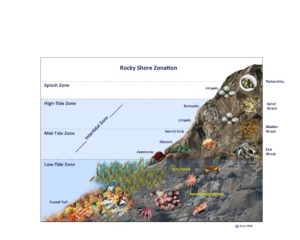Reefs
The rocky reefs along the Berwickshire and Northumberland coast provide some of the most diverse habitats in the North Sea. They encompass a wide variety of shapes and forms, providing a solid foundation for seaweeds and marine life to colonise. The daily tides create challenging conditions. Plants and animals are faced with drying out as the tide falls, predation by shore birds as they are exposed, changes in temperature and altered salinity levels due to rain water dilution or evaporation from the sun. As the tide returns, crashing waves and swirling currents create stormy conditions for marine life, who must then survive underwater until the tide falls again. A typical rocky shore is occupied by an astonishing variety of species and can be split into zones. Areas at the top of the shore are exposed for much longer periods compared to areas of the lower shore and this creates different environmental conditions, with different habitats supporting specific plants and animals who have adapted their body structure to survive life on the rocky shore.
The very highest zone on the shore is called the Splash Zone and, as the name suggests, is not directly flooded with the rising tide. This area of the shore has more in common with land habitats and acts as an interface between the land and sea. Lichens are a common species of the Splash Zone, which are grazed by small periwinkles (Littorina spp.) and pioneering limpets (Patella vulgata). The High-Tide Zone lies beneath the Splash Zone and is only submerged by the high spring tides for a short period of time. Two brown seaweeds – the Channelled Wrack (Pelvetia canaliculata) and the Spiral Wrack (Fucus spiralis) – have adapted to the dry conditions of this zone. Clusters of barnacles (Balanus crenatus) and limpets also settle in this area. The Mid-Tide Zone is submerged in water for half of the day and conditions can be extreme. The common brown seaweed of this zone is Bladder Wrack (Fucus vesiculosus), which shelters colonies of limpets and periwinkles who graze the rocks next to mussel beds. Beadlet and Dahlia anemones can be found in cool crevices, while shore crabs hide beneath boulders and rocks. The Low-Tide Zone is covered with water for most of the day with only a short exposure time, except when spring tides take the water further out and uncover this zone for longer periods. Saw Wrack (Fucus serratus) is a common brown seaweed, which gives way to large kelps at the very lowest part of the shore. The Low-Tide Zone is an excellent place to experience life beneath the waves with a fascinating collection of marine creatures living in the many rock pools. Echinoderms such as the common sun star (Crossaster papposus), crustacea such as the squat lobster (Galathea sqamifera), molluscs, small fish and prawns are often found in this zone. The abundance of life in the intertidal zone provides important sources of food for coastal birds and the Berwickshire and Northumberland coast supports high numbers of overwintering and migratory species.
The reef continues into the shallow sea where dense kelp forests fringe the coast providing shelter for an array of species, including juvenile fish who find safety and shelter amongst the swaying marine canopy. Deeper still, and the kelp forests disappear as daylight becomes weaker and the reefs give way to a colourful carpet of marine life. Animals such as sponges and anemones anchor themselves to the rocks, while mobile creatures such as crabs, lobsters and sea squirts hide in crevices.
Reefs are a designated interest feature of the Berwickshire and North Northumberland Coast SAC. Intertidal and subtidal rock are also an interest feature of the Coquet to St Mary’s MCZ.

